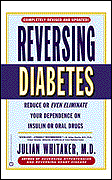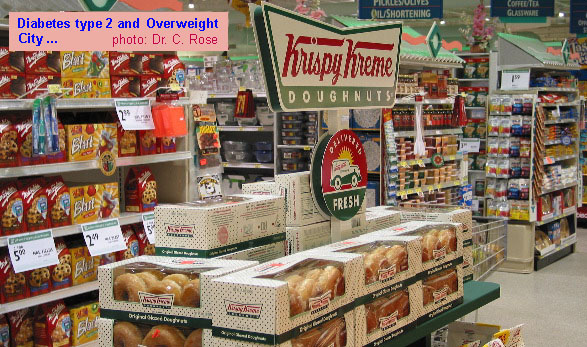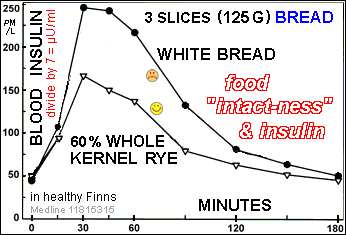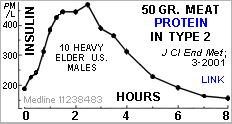[Diabetes & Weight] [Where] [Cholesterol] [Why] [More on Causes] [31 Tips & Info] [Index]
Both conditions are epidemic with 1 in 13 Americans and 1 in 3 of those over age 60 developing 'adult' diabetes. Most will develop heart, kidney, nerve and blood vessel diseases for an amazing 1/4th of total health care costs! Other countries have similar increasing rates. Later-in-life diabetes (during pregnancy being a warning) is an eventual one-way track to heart disease.
What makes a diabetic? Simply put: when your pre-breakfast blood sugar (plasma glucose) gets over 126 mg/dL (7 mmol/L). Another measure is when 2 hours after taking a dose of glucose the blood level is still over 200 mg/dL (11.1 mmol/L), with over 140 (7.8) starting to suggest a problem. Pre-breakfast 95 (5.3) is good, under 36 (2) is seriously low blood sugar, while above 180 (10) a safety-valve opens that sends glucose to the urine. To confuse anybody, the numbers changed from mg to the 18 times smaller mmole, they increase by 14% between 'blood' and 'plasma' in syringe samples -but the numbers for 'blood drop' and 'syringe-plasma' are similar. However, it's the big picture that counts, not the decimal points of the reading. This is one area where a blood test is important since serious organ or foot damage (!) can happen early.
In early-age 'type 1' diabetes the body stops making insulin [see: Wikipedia] needed to process sugar and starch. Type 1 represents under 5% of total diabetes. There is no cure and insulin, a protein, must be dosed by injection in relation to sugar and starch intake. Type 1 can possibly be prevented with vitamin B-3 in people with declining insulin -which can show years before irreversible damage [see ENDIT or here].
Both effects reduce blood flow to all areas of the body especially to the feet, eyes and kidneys.
Fat, around the body or as triglycerides in the blood, does nothing to promote blood circulation. Good circulation is 50%-of-good-health. This is why weight control, "shaking-up-the-fat" (exercise), a good multi-vitamin with minerals and extra magnesium, omega-3 [ω-3 or n-3] oils and high-fiber, low glycemic index foods are all-important. Unhelpful are high omega-6 oils like corn, soy or sunflower while vitamin D works better than insulin drugs! High waist size (belt length, regardless of your height) with high blood triglycerides (fats), high sugar, high insulin and high blood pressure, all lead to ill-health. This group of symptoms is known as Syndrome X, the Metabolic Syndrome.
|
 1. READ two pieces of literature. First, the 2001 paperback Reversing Diabetes by Dr. Whitaker. His website is very commercial but his science is truly excellent: a vital $15 investment.
Second, read the article (PDF) from the Nurses' Study by Harvard that found 2.5 x the risk getting diabetes is those eating most rapidly absorbed, low-fiber carbs.
1. READ two pieces of literature. First, the 2001 paperback Reversing Diabetes by Dr. Whitaker. His website is very commercial but his science is truly excellent: a vital $15 investment.
Second, read the article (PDF) from the Nurses' Study by Harvard that found 2.5 x the risk getting diabetes is those eating most rapidly absorbed, low-fiber carbs.The main 'offending' foods are: flour, boiled, baked or fried potatoes, most breakfast cereals and the like and noodles made from flour. Regular noodles made from semolina, gritty hard wheat core particles as in couscous, are low glycemic -- but also low in fiber and nutrients. Floury starches and carbs are high on the 'glycemic index' as they rapidly shoot glucose into your bloodstream for insulin to deal with, which eventually causes harm. P.S. Unlike some oils and proteins, no carbs are classified as 'essential nutrients'.
2. INCREASE fiber-rich vegetables and fruits that have not been processed much, beans and partially whole kernel grains (not finely ground) and omega-3 oils (flax, canola and fatty fish or fish-oil pills). Fiber, especially soluble fiber (gel or pectin-like fiber), is truly diabetes and heart healthy as it slows and regulates the speed of the uptake of foods--which is what diabetes control is all about. All agree about the major benefit of fiber -and it's cheaper than a glucose test strip. Every 10 g/day increase in fiber reduces diabetes risk by up to 30%! I'm not crazy about non-nutrient fiber, like psyllium husks a.k.a. Metamucil.
4. DECREASE YOUR WEIGHT if it is high: obesity leads to type 2 and heart disease. [Skinny diabetics, those not producing the fat-maker insulin, lose sugar-calories in the urine since they can't use sugar for fat or fuel.] ALL authorities agree with weight reduction benefits in type 2, as often blood-sugar returns below the cut-off point [and technically you're cured]. As fat-cells lose fats, there are relatively more insulin receptors active per unit of cell surface and the system works better. Moderate exercise (many benefits) and cutting down on (tasty and well-deserved) calories are ways to normalize weight. Easier said than done. Then there are changes in diet: try the wisdom in the books by Whitaker, Challem, Atkins and Willett (the 4 books in one frame in the links list). None of these books has all the answers but combined they provide a wealth of information about how weight loss can be part of a pleasant life-style. Low-carb Atkins 'still' best for weight loss. Another low carb high nutrient diet is Montignac. Obesity is stored fat, and you'll never lose fat if you over supply with starch, carbs and refined cereals...
Later-in-life, type 2, diabetes becomes a hard to manage "condition" with much confusion and changing recommendations between individuals or expert groups. Mega-dollars are spent on and by each diabetic so the money interests are huge. Adding to the confusion, fundamental understandings (like the role of inflammation) are just starting to emerge. It is a long way from studies to medical consensus and even further to supermarkets and restaurants --where the causes and solutions to diabetes and heart disease certainly lie. On a lighter note, there seems agreement (for people who are not driving, type 1, pregnant or alcoholic) that "...moderate alcohol consumption in the diet should not be discouraged" [JClEndMet; 3-2002], the benefit of a drink-or-two, and now there's coffee!
In California the doubled rate of type 2 diabetes in the 1990's was evidently not caused by a lack of drugs but, just maybe, by more low-fiber processed-foods [or by sitting in front of computers...]. But unlike your computer,
Many groups suggest to follow your doctor's advice about drugs. This may be valid but only after you have both read and digested the book Reversing Diabetes that deals with the many benefits of the non-drug approaches. As in any such disease, why not keep copies of lab-reports (with
MedlinePlus drug descriptions) and start a file on yourself. Knowledge is power, and unless you convince yourself about benefits, changes tend to be temporary while with drugs the slide continues.
March 24, 2017. About the author. Page in PDF. | ||||||
[Diabetes & Weight] [Where] [Cholesterol] [Why] [More on Causes] [31 Tips & Info] [Index]

 In the now exploding 'type 2' diabetes, which develops in obese kids or at a more 'mature' age [Non Insulin Dependent Diabetes Mellitus, NIDDM or maturity-onset], the problem is initially not a lack of insulin but body cells became insensitive (resistant) to its effects. Increasing amounts of insulin try to "push the gas pedal" but the system doesn't react (by taking fuel, glucose, into the cells). In type 2, blood-sugar and (therefore) blood-insulin both become high which is a double problem.
In the now exploding 'type 2' diabetes, which develops in obese kids or at a more 'mature' age [Non Insulin Dependent Diabetes Mellitus, NIDDM or maturity-onset], the problem is initially not a lack of insulin but body cells became insensitive (resistant) to its effects. Increasing amounts of insulin try to "push the gas pedal" but the system doesn't react (by taking fuel, glucose, into the cells). In type 2, blood-sugar and (therefore) blood-insulin both become high which is a double problem.
 3. LEARN ABOUT low glycemic index foods and glycemic load. Not all foods release their sugars or starches at the same speed. The slow release foods, typically the least refined foods, have demonstrated benefits. Here is a full list of
3. LEARN ABOUT low glycemic index foods and glycemic load. Not all foods release their sugars or starches at the same speed. The slow release foods, typically the least refined foods, have demonstrated benefits. Here is a full list of  whole grain structure reduced the insulin that was triggered by 50% [!]. This lingering high "white bread
insulin" lowered the 1.5 to 3 hour blood sugar to below starting levels. This causes cravings and jitters precisely because, despite of low blood-sugar, insulin prevents you from using fat reserves to satisfy such energy craving. [And, logically, only sugar, flour, starch and maybe alcohol can fix such craving --but not fat or protein]. Remember: lingering insulin makes and keeps you fat, ratcheting fat into the cells --and then preventing its use for energy
whole grain structure reduced the insulin that was triggered by 50% [!]. This lingering high "white bread
insulin" lowered the 1.5 to 3 hour blood sugar to below starting levels. This causes cravings and jitters precisely because, despite of low blood-sugar, insulin prevents you from using fat reserves to satisfy such energy craving. [And, logically, only sugar, flour, starch and maybe alcohol can fix such craving --but not fat or protein]. Remember: lingering insulin makes and keeps you fat, ratcheting fat into the cells --and then preventing its use for energy 

 5. ABOUT DRUGS... there are drugs that "raise insulin" [sic], make it work better or reduce blood-sugar by other means. In later stages of adult-diabetes [very high blood-sugar], injected insulin [at increased levels also a poison] is often added to drugs taken by mouth. On the surface this seems like good strategy as blood-sugar and therefore the blood marker HbA(1c) become more normal, for a while. This marker "A-one-C" tells how many "frosted" (sugar-damaged) red blood cells you have, evidently an important thing to reduce (less than 6% is normal, 4% is good but even
5. ABOUT DRUGS... there are drugs that "raise insulin" [sic], make it work better or reduce blood-sugar by other means. In later stages of adult-diabetes [very high blood-sugar], injected insulin [at increased levels also a poison] is often added to drugs taken by mouth. On the surface this seems like good strategy as blood-sugar and therefore the blood marker HbA(1c) become more normal, for a while. This marker "A-one-C" tells how many "frosted" (sugar-damaged) red blood cells you have, evidently an important thing to reduce (less than 6% is normal, 4% is good but even 
 The 2002 recommendations are
The 2002 recommendations are 